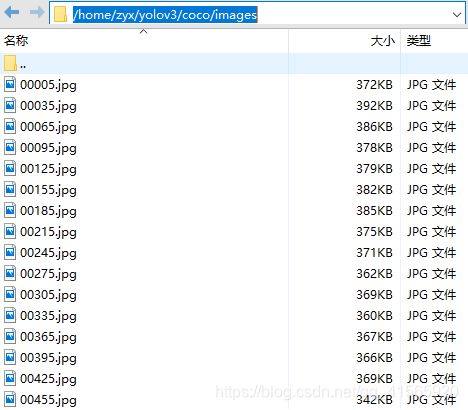windows下自制数据集,linux下pytorch实现yolov3
目录
- 1 环境搭建
- 2 数据集构造
-
- voc格式数据的构造
- 2.1 labellmg给数据画框得到xml格式文件
- 2.2 将样本打乱划分训练集等,生成txt文件
- 2.3 将对应图片名称的txt文件生成指向对应图片路径的txt文件
- 2.4 将xml格式的标注转化成txt形式的标注
- 3 制作对应的coco数据集格式
-
- 3.1 coco下创建image和labels文件夹,分别放所有图片和标准化后的所有labels
- 3.2 data下添加/更改coco.data,coco.names,2007_train.txt,2007_test.txt
- 4调整网络结构与配置
- 5 实战
-
- 5.1 训练
- 5.2 检测
- 6 参考
1 环境搭建
linux下
git clone https://github.com/ultralytics/yolov3.git
在自己的对应的conda环境下,cd到对用的yolov3文件夹中,安装所需要的包
pip install -r requirements.txt
要求
- python >= 3.6
- numpy
- torch >= 1.0.0
- opencv-python
- tqdm
2 数据集构造
voc格式数据的构造
windows环境下建立如图所示的空文件夹
- VOCdevkit2007
- VOC2007
- Annotations // 经过labellmg得到的xnl文件
- ImageSets
- Main
- JPEGImages // 先把你的jpg格式的图片放入这个文件夹
- labels
- VOC2007
2.1 labellmg给数据画框得到xml格式文件
工具的使用: 目标检测标注工具labelImg使用方法.
xml保存路径选择到Annotations所在路径下,一个图片对应一个xml文件。
打开Annotations下和上图对应的xml文件

object有两个就是刚才标注的汽车的框的位置 。
2.2 将样本打乱划分训练集等,生成txt文件
手动标注了100多张图片之后,╭(╯^╰)╮
VOC2007文件夹下运行该脚本 xml2txt. py.
import os
import random
trainval_percent = 0.8
train_percent = 0.8
xmlfilepath = 'Annotations'
txtsavepath = 'ImageSets\Main'
total_xml = os.listdir(xmlfilepath)
num = len(total_xml)
list = range(num)
tv = int(num * trainval_percent)
tr = int(tv * train_percent)
trainval = random.sample(list, tv)
train = random.sample(trainval, tr)
ftrainval = open('ImageSets/Main/trainval.txt', 'w')
ftest = open('ImageSets/Main/test.txt', 'w')
ftrain = open('ImageSets/Main/train.txt', 'w')
fval = open('ImageSets/Main/val.txt', 'w')
for i in list:
name = total_xml[i][:-4] + '\n'
if i in trainval:
ftrainval.write(name)
if i in train:
ftrain.write(name)
else:
fval.write(name)
else:
ftest.write(name)
ftrainval.close()
ftrain.close()
fval.close()
ftest.close()
现在Main文件夹中有了4个txt文件,点进train.txt对应着经过划分后的训练集的所要用的图片

2.3 将对应图片名称的txt文件生成指向对应图片路径的txt文件
VOCdevkit2007文件夹外运行 voc_label.py
"""
需要修改的地方:
1. sets中替换为自己的数据集
2. classes中替换为自己的类别
3. VOCdevkit2007文件夹外运行该脚本(对应生成的5个txt也在VOCdevkit2007文件夹外,
并不重要,重要的是得到了txt文件)
4. 直接开始运行
"""
import xml.etree.ElementTree as ET
import pickle
import os
from os import listdir, getcwd
from os.path import join
sets=[('2007', 'train'), ('2007', 'val'), ('2007', 'test')]
classes = ["car", "person"]
def convert(size, box):
dw = 1./(size[0])
dh = 1./(size[1])
x = (box[0] + box[1])/2.0 - 1
y = (box[2] + box[3])/2.0 - 1
w = box[1] - box[0]
h = box[3] - box[2]
x = x*dw
w = w*dw
y = y*dh
h = h*dh
return (x,y,w,h)
def convert_annotation(year, image_id):
in_file = open('VOCdevkit2007/VOC%s/Annotations/%s.xml'%(year, image_id))
out_file = open('VOCdevkit2007/VOC%s/labels/%s.txt'%(year, image_id), 'w')
tree=ET.parse(in_file)
root = tree.getroot()
size = root.find('size')
w = int(size.find('width').text)
h = int(size.find('height').text)
for obj in root.iter('object'):
difficult = obj.find('difficult').text
cls = obj.find('name').text
if cls not in classes or int(difficult)==1:
continue
cls_id = classes.index(cls)
xmlbox = obj.find('bndbox')
b = (float(xmlbox.find('xmin').text), float(xmlbox.find('xmax').text), float(xmlbox.find('ymin').text), float(xmlbox.find('ymax').text))
bb = convert((w,h), b)
out_file.write(str(cls_id) + " " + " ".join([str(a) for a in bb]) + '\n')
wd = getcwd()
for year, image_set in sets:
if not os.path.exists('VOCdevkit2007/VOC%s/labels/'%(year)):
os.makedirs('VOCdevkit2007/VOC%s/labels/'%(year))
image_ids = open('VOCdevkit2007/VOC%s/ImageSets/Main/%s.txt'%(year, image_set)).read().strip().split()
list_file = open('%s_%s.txt'%(year, image_set), 'w')
for image_id in image_ids:
list_file.write('%s/VOCdevkit2007/VOC%s/JPEGImages/%s.jpg\n'%(wd, year, image_id))
convert_annotation(year, image_id)
list_file.close()
os.system("cat 2007_train.txt 2007_val.txt > train.txt")
os.system("cat 2007_train.txt 2007_val.txt 2007_test.txt > train.all.txt")
打开对应的2007_train.txt

就是将原来的train.txt加了路径前缀和文件类型后缀嘛~ 这个文件之后是要修改的 ,路径要改成linux下对应的目录,因为我的linux没有图形界面,所以我是先windows制作好了数据集,更改路径,再传到了linux对应的路径中。
2.4 将xml格式的标注转化成txt形式的标注
voc_label.py后labels文件夹下也多了txt文件 (一个jpg对应一个xml标注和一个txt标注)

打开一个txt看一下 第一个数字0即类别car(100多张图片我只标注了0car 1person两类),剩下的四个参数即标准化后框边界的位置(可以从程序中看出)

VOC格式数据集构造完毕
文件夹结构
- VOCdevkit2007
- VOC2007
- Annotations // 经过labellmg得到的xnl文件
- 00005.xml
- ImageSets
- Main
- train.txt
- Main
- JPEGImages // 先把你的jpg格式的图片放入这个文件夹
- 00005.jpg…
- labels
- 00005.txt…
- Annotations // 经过labellmg得到的xnl文件
- VOC2007
- 2007_train.txt //图片对应的路径
3 制作对应的coco数据集格式
linux下
- yolov3
- cfg
- coco
- data
- weights
3.1 coco下创建image和labels文件夹,分别放所有图片和标准化后的所有labels
3.2 data下添加/更改coco.data,coco.names,2007_train.txt,2007_test.txt
在linux下进入yolov3文件夹,xftp下的linux的可视化
images文件夹下图片的路径复制到2007_test.txt中

修改2007_train.txt和2007_train.txt文件下对应的路径,修改完毕放入data文件夹下

data文件夹下创建coco.names文件,注意第一行对应 0类汽车,依次类推

data文件夹下更改coco.data文件
classes=2 # 自己的类
train = ./data/2007_train.txt
valid = ./data/2007_test.txt //在这里直接把验证集的路径写到了测试集里
names=data/coco.names
backup=backup/
当前的文件格式
- yolov3
- cfg
- coco
- image
- 00005.jpg…
- labels
- 00005.txt…
- image
- data
- coco.data
- coco.names
- 2007_train.txt
- 2007_test.txt
- weights
4调整网络结构与配置
打开cfg文件夹下的yolov3.cfg
[net]部分,主要更改subdivision和batch部分
其他参数的意义.

[yolo]和[yolo]层上的[convolutional]
总共有3个yolo层需要更改

5 实战
5.1 训练
更改train.py中的设置,14行处加入,设置成单路GPU,多路会出现address in use 错误,未能解决
os.environ['MASTER_PORT'] = '9901'
os.environ['CUDA_VISIBLE_DEVICES'] = '0'
命令行中,载入自己的数据和网络结构
python train.py --data data/coco.data --cfg cfg/yolov3.cfg
也可以在文件中将默认参数改为对应的路径, test. py 和 detect.py同理。

第一次训练会加载weights文件下的预训练参数,之后的输出如下,每次迭代的结果的评价指标也都与显示,对测试集36张图片的mPA计算
Namespace(accumulate=1, backend='nccl', batch_size=16, cfg='cfg/yolov3.cfg', data_cfg='data/coco.data', dist_url='tcp://127.0.0.1:9999', epochs=273, evolve=False, img_size=416, multi_scale=False, nosave=False, notest=False, num_workers=4, rank=0, resume=False, transfer=False, var=0, world_size=1)
Using CUDA device0 _CudaDeviceProperties(name='GeForce GTX 1080 Ti', total_memory=11178MB)
Reading images: 100%|███████████████████████████████████████████████████████████████████████████████████████████████████████████████████████████████████████| 115/115 [00:01<00:00, 87.79it/s]
Model Summary: 222 layers, 6.15291e+07 parameters, 6.15291e+07 gradients
Epoch Batch xy wh conf cls total nTargets time
QXcbConnection: Failed to initialize XRandr
0/272 0/7 0.85 1.69 151 1.28 154 78 84.4
0/272 1/7 0.804 1.73 151 1.3 154 73 0.314
0/272 2/7 0.784 1.74 151 1.31 154 71 0.312
0/272 3/7 0.777 1.7 150 1.31 153 90 0.31
0/272 4/7 0.778 1.6 145 1.3 148 81 0.311
0/272 5/7 0.771 1.51 138 1.3 141 80 0.313
0/272 6/7 0.765 1.41 130 1.28 134 80 0.31
0/272 7/7 0.684 1.26 115 1.15 118 11 1.9
Reading images: 100%|█████████████████████████████████████████████████████████████████████████████████████████████████████████████████████████████████████████| 36/36 [00:00<00:00, 80.61it/s]
Class Images Targets P R mAP F1
Computing mAP: 100%|████████████████████████████████████████████████████████████████████████████████████████████████████████████████████████████████████████████| 3/3 [00:08<00:00, 3.35s/it]
all 36 114 0 0 0 0
car 36 73 0 0 0 0
person 36 41 0 0 0 0
迭代完成后的结果在yolov3文件夹下的 results.txt 中,在juputer中运行一下代码可视化了迭代的参数变化
import glob
import random
import cv2
import matplotlib
import matplotlib.pyplot as plt
import numpy as np
import torch
import torch.nn as nn
def plot_results(start=0, stop=0): # from utils.utils import *; plot_results()
# Plot training results files 'results*.txt'
# import os; os.system('wget https://storage.googleapis.com/ultralytics/yolov3/results_v3.txt')
fig, ax = plt.subplots(2, 5, figsize=(14, 7))
ax = ax.ravel()
s = ['X + Y', 'Width + Height', 'Confidence', 'Classification', 'Train Loss', 'Precision', 'Recall', 'mAP', 'F1',
'Test Loss']
for f in sorted(glob.glob('results.txt')):
results = np.loadtxt(f, usecols=[2, 3, 4, 5, 6, 9, 10, 11, 12, 13]).T
n = results.shape[1] # number of rows
x = range(start, min(stop, n) if stop else n)
for i in range(10):
ax[i].plot(x, results[i, x], marker='.', label=f.replace('.txt', ''))
ax[i].set_title(s[i])
fig.tight_layout()
ax[4].legend()
fig.savefig('results.png', dpi=300)
plot_results()
类似这样,100多张训练的结果一般般,数据多了精度自然会上去

5.2 检测
data文件夹下的samples文件夹下放入要检测的图片。
命令行中,输入
python3 detect.py --weights weights/latest.pt
image 1/8 data/samples/00000.jpg: 160x416 2 cars, Done. (0.146s)
image 2/8 data/samples/00005.jpg: 160x416 2 cars, Done. (0.017s)
image 3/8 data/samples/01050.jpg: 160x416 2 cars, Done. (0.017s)
image 4/8 data/samples/01200.jpg: Done. (0.013s)
image 5/8 data/samples/02220.jpg: Done. (0.013s)
image 6/8 data/samples/02430.jpg: 160x416 2 cars, Done. (0.017s)
image 7/8 data/samples/bus.jpg: 416x320 1 persons, Done. (0.018s)
image 8/8 data/samples/zidane.jpg: Done. (0.016s)
Results saved to /home/***/yolov3/output
6 参考
yolov3官网.
目标检测:YOLOv3: 训练自己的数据.
github:Train Custom Data.
pytorch版yolov3训练自己数据集

